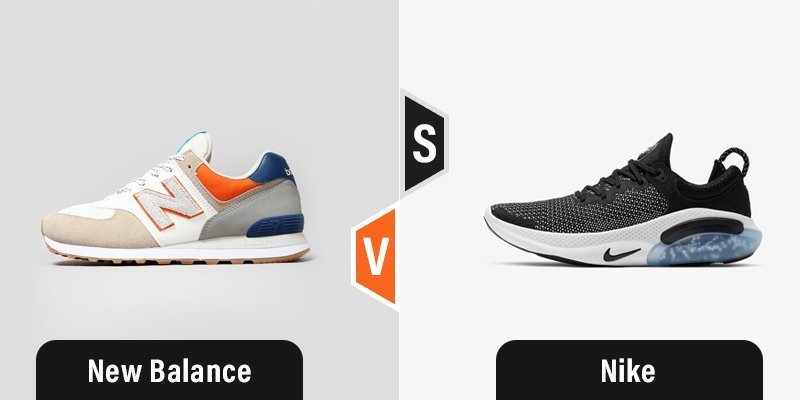Understanding the Fit of Nike Shoes: A Brief Overview
Nike shoes are renowned for their sleek designs, innovative technology, and comfortable fit. Popular Nike models such as the Air Max, Pegasus, and Vomero series cater to a wide range of athletes and activities. Typically, Nike shoes follow a standard sizing system, but it is crucial to consider the fit when purchasing new shoes. A proper fit can significantly impact comfort and performance during various physical activities.
Exploring the Fit of New Balance Shoes: A Closer Look
New Balance shoes are recognized for their exceptional comfort, durability, and versatility. Popular New Balance models such as the 860, 990, and 1080 series cater to various foot types and activities. New Balance is committed to offering a range of widths, from 2A (narrow) to 6E (extra wide), to accommodate different foot shapes and sizes. This commitment to width variety sets New Balance apart from many other shoe brands.
When trying on New Balance shoes, it is essential to ensure a proper fit. A snug heel, adequate toe room, and comfortable arch support are all crucial factors to consider. The shoe should feel secure but not overly tight, allowing for natural foot movement and flexibility.
Comparing the Fit of New Balance and Nike Shoes: A Side-by-Side Analysis
When comparing the fit of New Balance and Nike shoes, there are several factors to consider. Both brands offer a variety of popular models tailored to different foot types and activities. However, the fit can vary significantly between individuals due to factors such as length, width, and overall feel.
Length-wise, Nike shoes tend to fit true to size, while New Balance shoes can sometimes run a bit larger. It is essential to measure your feet and compare them to the brand’s size chart to ensure the best fit. When it comes to width, New Balance outperforms Nike by offering a wider range of options to accommodate different foot shapes. This can be particularly beneficial for individuals with wide or narrow feet.
The overall feel of the shoes can also impact the fit. Nike shoes often have a snugger, more form-fitting feel, while New Balance shoes provide a roomier, more spacious fit. Personal preferences and activity levels should guide your decision when choosing between the two brands. For instance, runners may prefer a more fitted feel, while those engaging in low-impact activities might opt for a roomier fit.
Real-Life Comparisons: New Balance vs. Nike Shoes
Real-life experiences and testimonials from customers who have worn both New Balance and Nike shoes can provide valuable insights into the fit and comfort of each brand. Many customers have praised New Balance for its generous width options and roomy toe boxes, which can be particularly beneficial for individuals with wider feet or those seeking a more spacious fit.
“I have always struggled to find shoes that fit my wide feet comfortably. New Balance has been a game-changer for me. Their shoes offer ample room in the toe box and come in various widths, ensuring a perfect fit,” shared one satisfied customer.
On the other hand, Nike shoes have received praise for their snug, form-fitting feel, which can be advantageous for athletes seeking a secure fit during high-intensity activities. A Nike customer raved, “I love how Nike shoes fit like a glove. They provide excellent support and never feel bulky, even during intense workouts.”
Trying on New Balance and Nike Shoes: A How-To Guide
To ensure the best fit when trying on New Balance and Nike shoes, follow these steps:
-
Measure your feet: Use a Brannock device or a mobile app to measure the length and width of your feet. Compare your measurements to the brand’s size chart to determine your correct size.
-
Consider width options: Both New Balance and Nike offer various widths. Be sure to explore these options and select the width that best accommodates your foot shape.
-
Check the arch support: Ensure that the shoe provides adequate arch support for your foot type. If necessary, consider adding orthotic inserts for additional support.
-
Test the shoes for comfort and stability: Walk, jog, and perform any activity-specific movements in the shoes. Pay attention to any areas of discomfort or instability, as these can indicate a poor fit or an unsuitable shoe model.
-
Try on both shoes: It’s essential to ensure that both shoes fit correctly, as slight differences between the left and right shoes can lead to discomfort or injury.
-
Consider the break-in period: Some shoes may require a break-in period before achieving optimal comfort. Be aware of this when making your decision, and factor in the amount of time you’re willing to invest in breaking in your new shoes.
Finding the Right Fit: Tips for Those with Wide or Narrow Feet
For individuals with wide or narrow feet, finding the perfect fit in New Balance and Nike shoes can be challenging. However, both brands offer solutions to accommodate various foot shapes. Here are some tips to help you find the best fit:
Wide Feet:
-
New Balance: New Balance is well-known for its wide range of width options. When trying on New Balance shoes, consider models that cater to wider feet, such as the 990 series or the 860 series. These models offer widths up to 6E, ensuring a comfortable fit for wider feet.
-
Nike: Nike offers width options for some of its popular models, including the Air Zoom Pegasus and the Air Max series. Look for models with widths up to 2E or 4E, depending on your foot shape.
Narrow Feet:
-
New Balance: New Balance provides narrow width options in many of its models, typically marked as 2A. Consider models like the 890 series or the 1500 series, which offer narrower widths for a snugger fit.
-
Nike: Nike’s narrow width options are less common but can be found in some models, such as the Air Zoom Vomero and the Air Max series. Opt for models with a narrower fit if available.
Regardless of foot width, it’s essential to consider the break-in period when purchasing new shoes. Wider feet may require a more extended break-in period to stretch and conform to the shoe’s structure. Narrow feet might experience some initial tightness, which should subside as the shoe molds to the foot.
Making the Final Decision: New Balance or Nike Shoes?
When deciding between New Balance and Nike shoes, it’s crucial to consider personal preferences, foot type, and activity level. Both brands offer high-quality shoes with unique fits and features. Here are some guidelines to help you make an informed decision:
-
Foot Type: If you have wider feet, New Balance may be the better option due to its extensive range of width options. However, Nike also offers some width options for popular models.
-
Activity Level: For high-intensity activities, Nike’s snug, form-fitting shoes might be more suitable. In contrast, New Balance’s roomier designs could be more comfortable for low-impact activities or everyday wear.
-
Comfort and Stability: Always prioritize comfort and stability when trying on shoes. Ensure that the shoes fit properly, provide adequate arch support, and do not cause discomfort or instability during activity-specific movements.
-
Personal Preferences: Your personal preferences and brand loyalty play a significant role in your decision. Consider the aesthetics, technology, and overall feel of the shoes when making your choice.
Ultimately, the decision between New Balance and Nike shoes comes down to individual needs and preferences. By considering these factors and following the tips provided in this comprehensive guide, you can find the perfect pair of shoes to support your feet and enhance your performance.
Maintaining the Fit: How to Care for Your New Balance or Nike Shoes
Proper care and maintenance can help ensure that your New Balance or Nike shoes maintain their fit and longevity. Here are some tips on cleaning, storing, and replacing your shoes as needed:
Cleaning:
-
New Balance: Use a soft brush or cloth and mild detergent to clean your New Balance shoes. Avoid using bleach or harsh chemicals, as they can damage the materials. Allow the shoes to air dry completely before wearing them again.
-
Nike: For Nike shoes, follow the manufacturer’s cleaning instructions. In general, you can use a soft brush or cloth and mild detergent to clean the exterior. Avoid submerging the shoes in water, as this can damage the midsole and other components.
Storing:
-
New Balance and Nike: Store your shoes in a cool, dry place away from direct sunlight. Avoid storing them in damp or humid areas, as this can lead to mold growth and material degradation. Consider using a shoe tree or stuffing the toes with paper to help maintain their shape.
Replacing:
-
New Balance and Nike: Replace your shoes when they show signs of wear, such as reduced cushioning, worn-out tread, or visible damage to the upper materials. As a general rule, consider replacing your shoes every 300 to 500 miles (483 to 805 kilometers) for running shoes or every six to twelve months for everyday wear, depending on usage.
By following these care and maintenance tips, you can help ensure that your New Balance or Nike shoes fit properly and last as long as possible. Regularly inspect your shoes for signs of wear and replace them when necessary to maintain their fit and performance.







